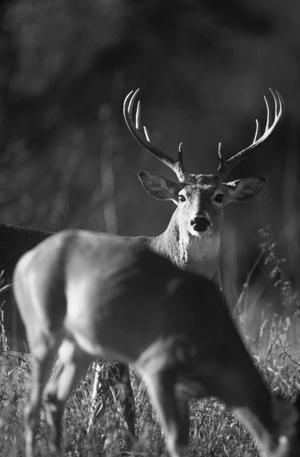by John Jefferson
 Predicting hunter success in a forthcoming deer season is risky, but most of this forecast comes from wildlife biologists at Texas Parks and Wildlife Department (TPWD). They study deer professionally.
Predicting hunter success in a forthcoming deer season is risky, but most of this forecast comes from wildlife biologists at Texas Parks and Wildlife Department (TPWD). They study deer professionally.
Alan Cain is TPWD’s white-tail deer program leader. He says, in short, that from data and personal observations and those of other field biologists working for him, Texas hunters can expect an average year for deer quality, and an average to above-average year for the number of deer harvested.
Before antler quality is even mentioned, let it be said that TPWD is encouraging all hunters to help make that last bit of the prediction a reality. The past two fawn crops have been large ones, with high survival rates. Texas currently has over four million deer, statewide – the highest estimate in 12 years! Some areas are already over-populated, and other areas will join them by next summer. Hunters should harvest as many as the law and their hunting licenses allow this season to make room for 2018’s fawns.
Weather forecaster say Texas will probably have a warmer, drier winter than usual. That sounds like favorable breeding conditions — as if Texas deer need fair weather to flirt. More than adequate rainfall has the habitat in excellent condition, so above-average breeding of healthy does could mean a bumper crop of baby deer next summer.
The Edwards Plateau – affectionately called the Hill Country – has the highest deer population in Texas, roughly 130 deer/1,000 acres. Llano and Mason counties have about 285/1,000 acres. Neighboring counties are also high.
Most of the state had good habitat conditions during winter and early spring which gave bucks a good start on growing antlers. The spigot got turned off in late spring and summer, keeping antler growth down, somewhat. Expect “average antlers”. Ranches with good supplemental feeding programs, though, may see better quality. Trophy bucks are already being seen in many places.
The Cross Timbers Region, running from the Hill Country all the way to Oklahoma, has the second largest deer population. Hunters there and in the Hill Country should see many bucks in the 4.5, 5.5 and 7.5 age classes, with mature antlers. A good acorn crop may make hunting hard early in the season, however.
West of Albany, the Rolling Plains Region is drier with fewer deer, but has higher buck age classes, and better average antlers – especially in the western portion.
South Texas produces the most ”trophy bucks” due to nutritious habitat, lower deer densities, and ranches intensely managed for quality hunting. Summer heat took a toll on the fawn crop, but a good mesquite bean crop and late summer rains have deer in fine condition.
Consistent summer rain in the Pineywoods have deer in good shape body-wise with above-average antlers. The rest of the state is relatively unchanged from last season, but antler restrictions continue to improve age structures, and consequently antlers.
It’s gonna’ be a good season throughout Texas. In most areas, it opens Saturday, November 4.
JJ
TPWD WILDLIFE BIOLOGISTS PREDICT an average deer season for Texas hunters, but an “average “ season in Texas is a bonanza in most states. (photo by John Jefferson)




